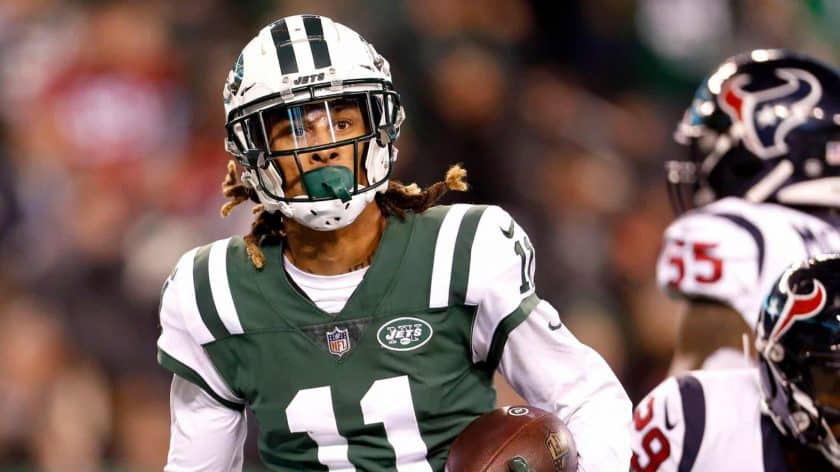New York Jets rumors: Trading Robby Anderson would be a major mistake

With the draft drawing near, the New York Jets shouldn’t even think about trading wide receiver Robby Anderson.
[sc name=”Michael Nania Banner”]Recently, Tony Pauline of Draft Analyst stated that the New York Jets could be interested in trading wide receiver Robby Anderson. Early speculation was that the Jets were looking for a third-round pick, but at this point, their asking price remains unknown.
It would a clear mistake for the Jets to trade Anderson for merely a third-round pick. Let’s go over some of the primary reasons why.
[sc name=”Jets Title” text=”A third-round pick is very unlikely to match Anderson’s production” ]Pro-Football-Reference tracks a stat called “approximate value,” or “AV” for short. The goal of the stat is to capture the worth of a player with a single number.
Through the first three years of his career, Anderson has accumulated an AV score of 17 for the Jets. It’s a solid number, the stuff of a good starter.
How likely are the Jets to find a player in the third round who will match or beat that contribution level?
Let’s go back three years and compare Anderson to the third-rounders of his draft class in 2016.
Thirty-five players were taken in the third round that year. Of those, only seven of them (20%) have accumulated an AV score of 17 or better over their first three years in the league thus far.
Let’s get more specific and compare Anderson against his own position. How often have third-round wide receivers produced in the NFL at the level Anderson has?
Robby Anderson has collected 2,280 receiving yards so far.
Of the 56 third round wide receivers taken from 2007-2016, only three of them (5%) had more receiving yards through their first three years than Anderson—Keenan Allen, Mike Wallace, and T.Y. Hilton.
Clearly, the odds are not very favorable that the Jets will find a player capable of producing at the level Anderson has.
[sc name=”Jets Title” text=”The Jets cannot afford to open up another wide receiver hole” ]As things stand right now, the Jets have a solid trio in place at wide receiver with Anderson, Quincy Enunwa, and the newly-inked Jamison Crowder.
While the group is devoid of a superstar, the three players complement each other very well. Each has his own particular set of skills in which they excel.
The Jets clearly seem committed to heading into 2019 with this group. They gave Enunwa a healthy extension, signed Crowder to a relatively meaty deal, and slapped Anderson with a second-round tender to keep him from being poached by a rival. Behind those three, the best reserve on the roster would probably be the unproven Deontay Burnett.
[sc name=”Jets Center”]New York already has a roster ridden with holes. Even with the four quality additions they made in early March, the Jets still need serious help at center, cornerback, edge rusher, and even on the defensive line.
To add wide receiver to that list at this point in the offseason wouldn’t be the most prudent order of business. This is especially true when the team needs to be doing its best to support a certain young prospect under center—which brings us to perhaps the top reason the Jets should hang on to Robby Anderson.
[sc name=”Jets Title” text=”Sam Darnold and Robby Anderson were developing a rapport at the end of 2018″ ]After Sam Darnold returned from injury to start the final four games of the season, he and Anderson finally started to click together. They seemed to be planting the seeds of a connection that could grow into something special.
Over the four games following Darnold’s return, Anderson collected 23 catches for 336 yards and three touchdowns, generating a 112.8 passer rating when targeted. From Weeks 14-17, DeAndre Hopkins and Julio Jones were the only other WRs to match all of those numbers.
This hot stretch continued a trend of Anderson’s that began late in the 2017 season. He has produced at borderline elite levels when his starters have been healthy, but he has faltered when his starters have gone down.
In the six games over the last two seasons in which his starter did not play the majority of the game, Anderson posted only 20 catches for 190 yards (31.7 per game) and zero touchdowns, while averaging a very poor 4.75 yards per target.
In 24 games started and finished by his starting quarterback over the last two seasons, Anderson racked up 93 catches for 1,503 yards (62.6 per game) and 13 touchdowns, while averaging a sterling 8.95 yards per target. Over 16 games, that would put him on pace for 63 catches, 1,002 yards, and nine touchdowns.
To put into perspective how good those numbers are, the only players in 2018 to post 60-plus catches, 1000-plus yards, 9-plus TDs, and 8.5-plus yds/target were Tyreek Hill, Michael Thomas, DeAndre Hopkins, Adam Thielen, and Travis Kelce.
Darnold can use all the weapons he can get as he looks to break out in his sophomore season. Taking away the explosive firearm he was just starting to get familiar with certainly wouldn’t be the best way to help him out.
[sc name=”Jets Link Next” link=”https://elitesportsny.com/2019/04/24/new-york-jets-nfl-draft-day-3-easter-egg-team/” text=”New York Jets: The NFL Draft Day 3 Easter Egg Team” ]Jets/NFL at ESNY ----- Twitter: @Michael_Nania ----- Cool Your Jets Podcast with Ben Blessington






